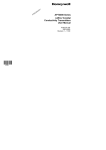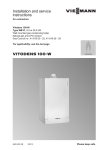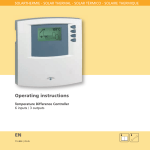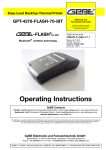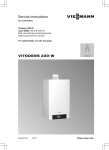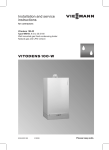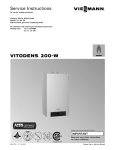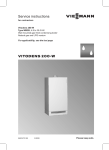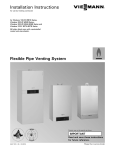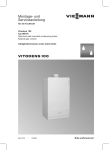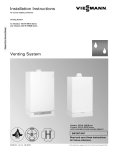Download Viessmann Vitodens 100-W Operating instructions
Transcript
Installation and service instructions VIESMANN for contractors Vitodens 100-W Type WB1B, 7.9 to 26.0 kW Wall mounted gas fired condensing boiler Natural gas and LPG version Gas council no.: 41-819-21; 41-819-22; 41-819-23; 41-819-24 VITODENS 100-W 5368 662 GB 2/2009 Please keep safe. Safety instructions Safety instructions Please follow these safety instructions closely to prevent accidents and material losses. Safety instructions explained Danger This symbol warns against the risk of injury. ! Please note This symbol warns against the risk of material losses and environmental pollution. Note Details identified by the word "Note" contain additional information. ■ all current safety regulations as defined by DIN, EN, DVGW, TRGI, TRF, VDE and all locally applicable standards, ■ Gas Safety (Installation & Use) Regulations – the appropriate Building Regulation either the Building regulations, the Building Regulation (Scotland), Building Regulations (Northern Ireland), – the Water Fittings Regulation or Water Bylaws in Scotland, – the current I.E.E. Wiring Regulations. Target group If you smell gas Regulations Observe the following when working on this system ■ all legal instructions regarding the prevention of accidents, ■ all legal instructions regarding environmental protection, ■ the Code of Practice of relevant trade associations, 2 Danger Escaping gas can lead to explosions which may result in serious injury. ■ Never smoke. Prevent naked flames and sparks. Never switch lights or electrical appliances ON or OFF. ■ Close the gas shut-off valve. ■ Open windows and doors. ■ Remove all people from the danger zone. ■ Notify your gas or electricity supplier from outside the building. ■ Shut off the electricity supply to the building from a safe place (outside the building). 5368 662 GB These instructions are exclusively designed for qualified personnel. ■ Work on gas equipment must only be carried out by a qualified gas fitter. ■ Work on electrical equipment must only be carried out by a qualified electrician. ■ The system must be commissioned by the system installer or a qualified person authorised by the installer. Safety instructions Safety instructions (cont.) If you smell flue gas Danger Flue gas can lead to life-threatening poisoning. ■ Shut down the heating system. ■ Ventilate the boiler room. ■ Close all doors leading to the living space. Repair work ! Please note Repairing components which fulfil a safety function can compromise the safe operation of your heating system. Replace faulty components only with original Viessmann spare parts. Working on the system ■ When using gas as fuel, also close the main gas shut-off valve and safeguard against unauthorised reopening. ■ Isolate the system from the power supply and check that it is no longer 'live', e.g. by removing a separate fuse or by means of a main isolator. ■ Safeguard the system against unauthorised reconnection. Please note Electronic modules can be damaged by electro-static discharges. Touch earthed objects, such as heating or water pipes, to discharge static loads. ! Please note Spare and wearing parts which have not been tested together with the heating system can compromise its function. Installing non-authorised components and non-approved modifications/conversion can compromise safety and may invalidate our warranty. For replacements, use only original spare parts from Viessmann or those which are approved by Viessmann. 5368 662 GB ! Ancillary components, spare and wearing parts 3 Index Index Installation instructions Preparing for installation Product information.............................................................................................. Preparing for installation....................................................................................... 5 5 Installation sequence Installing the boiler and making all connections................................................... 8 Opening the control unit casing............................................................................ 11 Electrical connections........................................................................................... 12 Service instructions Commissioning, inspection, maintenance Steps - commissioning, inspection and maintenance.......................................... 15 Further details regarding the individual steps....................................................... 16 Troubleshooting Function sequence and possible faults................................................................ 26 Fault messages on the display............................................................................. 27 Repairs................................................................................................................. 31 Gas type conversion Converting from LPG to natural gas..................................................................... 37 Control unit Functions and operating conditions in weather-compensated mode................... 39 Designs Connection and wiring diagram............................................................................ 40 Parts lists............................................................................................................ 42 Specification....................................................................................................... 45 Certificates Declaration of conformity...................................................................................... 46 5368 662 GB Keyword index.................................................................................................... 47 4 Preparing for installation Product information Vitodens 100-W, WB1B Set up for operation with natural gas. Preparing for installation Preparing the boiler installation 375 93 285 151 25 26 43 47 Installation Dimensions and connections 600 A B D C 5368 662 GB 119 A Heating flow B Heating return 123 C Condensate drain: Plastic pipe 7 22 mm 5 Preparing for installation Preparing for installation (cont.) D Gas connection, 1/2" male iron Fitting the wall retainer 25 150 ≥250 B Ø1 0 A Vitodens installation template 6 B Opening for the balanced flue 5368 662 GB A Preparing for installation Preparing for installation (cont.) 1. Position the installation template provided on the wall. 2. Mark out the rawl plug holes. 3. Drill 710 mm holes and insert the rawl plugs provided. 2. Prepare gas connection. 3. Prepare the electrical connections. Observe valid IEEE standards. ■ A 1.5 m long power cable is fitted as standard. ■ Accessory cables: NYM-O two-core min. 0.5 mm2. Installation 4. Secure wall retainer with screws provided. Preparing the connections 5368 662 GB 1. Prepare the water connections. Flush the heating system. 7 Installation sequence Installing the boiler and making all connections Removing the front panel and mounting the boiler 3. 2. 1. 2x 1. Release screws at the bottom of the boiler; do not remove completely. 3. Hook the boiler into the wall retainer. 5368 662 GB 2. Remove front panel. 8 Installation sequence Installing the boiler and making all connections (cont.) Installing connections on the water side Installation A B A Heating flow B Heating return Gas connection 1. Connect gas shut-off valve to connection A. 2. Carry out a tightness test. ! A Please note Excessive test pressure may damage the boiler and gas valve. Max. test pressure 150 mbar. Where higher pressure is required for tightness tests, separate the boiler and gas valves from the gas supply pipe (undo the fitting). 5368 662 GB 3. Vent the gas line. 9 Installation sequence Installing the boiler and making all connections (cont.) Condensate connection Connect condensate drain A with a slope and pipe vent to the public sewer. Observe the local waste water regulations. Note Fill the siphon with water before commissioning. A Filling the siphon with water Fill the flue gas connection with a minimum of 0.3 l of water. Please note During commissioning, flue gas may be emitted from the condensate drain. Fill the siphon with water immediately prior to commissioning. 5368 662 GB ! 10 Installation sequence Installing the boiler and making all connections (cont.) Balanced flue connection A B Connect the balanced flue. During installation and positioning of the flue system, observe building regulations part L, J and BS 5440 Part 1 and 2. Installation Flue system installation instructions. A Flue gas B Ventilation air Opening the control unit casing Please note Electronic modules can be damaged by electrostatic discharge. Before beginning work, touch earthed objects, such as heating or water pipes, to discharge static loads. 5368 662 GB ! 11 Installation sequence Opening the control unit casing (cont.) 2. 3. 1. 4x Electrical connections 5368 662 GB Information regarding the connection of accessories For connection of accesseries, observe the separate installation instructions provided with the accessories. 12 Installation sequence Electrical connections (cont.) X7 GAS FAN ?LN 1 LN X20 B PUMP 5 D X1 E F Installation X21 4 3 2 1 C A Note Pump can be connected externally of the boiler through the external terminal box A Only for weather-compensated mode: Outside temperature sensor (accessory) B Lead (accessory) C Terminal box cylinder demand (accessory; see separate installation instructions) D Jumper (remove when connecting a room thermostat or switched live for 'Y' or 'S' Plan installation) E Power supply (230 V, 50 Hz). Danger Incorrect wire allocation can cause severe injuries and damage to the equipment. Take care not to interchange wires "L1" and "N". The power supply must be equipped with a neutral conductor. Water pipes should be connected to the earth bonding of the house in question. F Vitotrol 100 (room thermostat) or onsite room temperature controller 5368 662 GB Separate installation instructions or Input for Y-plan or S-plan heating systems 13 Installation sequence Electrical connections (cont.) Outside temperature sensor (accessory) 1. Plug the lead supplied with the outside temperature sensor into socket "X21". 2. Connect the outside temperature sensor to terminals 3 and 4. Routing leads and closing control unit casing ! Please note Leads will be damaged if they come into contact with hot parts. When routing and securing leads on site, ensure that the maximum permissible temperatures for these cables are not exceeded. 3. 1. 5368 662 GB 2. 14 Commissioning, inspection, maintenance Steps - commissioning, inspection and maintenance For further information regarding the individual steps, see the page indicated Commissioning steps Inspection steps Maintenance steps • • • • 1. Filling the heating system.............................................. 16 2. Converting to operation with LPG................................ 16 3. Checking the CO2 or O2 content.................................... 18 • • • • 4. Burner removal .............................................................. 20 • • • • • • 6. Checking and adjusting electrodes.............................. 22 • • 9. Burner installation ......................................................... 24 • • • • • • • • • 11. Checking electrical connections for tightness • • 13. Fitting the front panel..................................................... 25 7. Cleaning the heat exchanger......................................... 22 8. Checking the condensate drain and cleaning the siphon.............................................................................. 23 10. Checking all connections on the heating water side and DHW side for leaks 12. Checking gas equipment for tightness at operating pressure .......................................................................... 25 14. Instructing the system user........................................... 25 5368 662 GB • 5. Checking the burner gasket and the burner gauze assembly......................................................................... 21 15 Service • • • Page Commissioning, inspection, maintenance Further details regarding the individual steps Filling the heating system ! Please note Unsuitable fill water increases the level of deposits and corrosion and may lead to boiler damage. ■ Thoroughly flush the heating system prior to filling it with water. ■ Only use fill water of potable quality. ■ Soften fill water harder than 300 ppm. ■ An antifreeze additive suitable for heating systems can be mixed with the fill water. Fill and vent heating system. Converting to operation with LPG In the delivered condition, the boiler is set up for operation with natural gas. For operation with LPG, the gas nozzle must be changed and the gas type converted in the control unit. Changing from LPG to natural gas - see page 37. 5368 662 GB Separate installation instructions. 16 Commissioning, inspection, maintenance Further details regarding the individual steps (cont.) 10 -1 +2 Checking and adjusting the ignition and ionisation electrodes 0,5 5+ Check all clearances. If the gaps are not as specified or the electrode is damaged, replace and align the electrode together with new gaskets. Tighten the electrode fixing screws. (2.5 Nm approx.). 5368 662 GB Check the electrode for wear and contamination Clean the electrode with a small brush (not with a wire brush) or emery paper. 17 Service A Ignition and ionisation electrode Commissioning, inspection, maintenance Further details regarding the individual steps (cont.) Checking the CO2 or O2 content Vitodens 100-W is factory-set for natural gas. During commissioning or maintenance, the CO2 and CO have to be measured at the boiler flue adaptor test point to check the flue integrity. Subject to the Wobbe index, the CO2 content fluctuates between 7.4 % and 10.5 %. And CO of up to 500 ppm is acceptable. We recommend to measure O2 as the value is unmistakable regarding lambda (air/gas). The O2-content fluctuates between 7.5 % and 3.2 %. Or alternatively CO/CO2 ratio has to be less than 0.004. If the actual CO2 or O2 and CO values deviate from the stated range, check the balanced flue systems for leaks. If flue installation is o.k., change the gas valve. 1. Connect a flue gas analyser at flue gas port A on the boiler flue connection. 2. Start the boiler. A 3. Turn rotary selector "tr" clockwise for less than 2 s and then anticlockwise back to the control range on the right. The display shows "SERV" and the boiler water temperature is shown. 5368 662 GB r 18 Commissioning, inspection, maintenance Further details regarding the individual steps (cont.) 4. Adjust the upper output: Turn rotary selector "tr" to the control range on the right. The display shows 5 bars for upper output. 5. Measure the CO2 content for upper output. The CO2 content must be between 7.4 and 10.5 %. 6. Adjust the lower output: Turn rotary selector "tr" to the left control range. The display shows 1 bar for lower output. 7. Test the CO2 content for lower output. The CO2 content must be between 7.4 and 10.5 %. 5368 662 GB 9. Shut the boiler down, remove flue gas analyser and close flue gas port A. 19 Service 8. If the CO2 content is not within the given range, check the flue gas/ventilation air system for tightness. Remedy any leaks. Commissioning, inspection, maintenance Further details regarding the individual steps (cont.) Burner removal 4x E C B A D 1. Switch OFF the power. 6. Disconnect gas supply pipe D fitting. 2. Shut off the gas supply. 3. Disconnect electrical cables from fan motor A, gas valve B. 4. Open control unit casing (see page 11) and pull out the lead to ignition electrode C. 7. Undo four screws E and remove the burner. ! Please note To prevent damage, never rest the burner on the gauze assembly. 5368 662 GB 5. Disconnect the venturi extension from fan A. 20 Commissioning, inspection, maintenance Further details regarding the individual steps (cont.) Checking the burner gasket and the burner gauze assembly Check burner gasket A for damage and replace if required. Replace the burner gauze assembly if it is damaged. E D C A 4x B 2. Undo the three cheese-head screws and remove thermal insulation ring C. 5. Refit thermal insulation ring C. Fixing screw torque: 3.5 Nm. 6. Refit electrode B. Fixing screw torque: 3.5 Nm. Service 1. Remove electrode B. 5368 662 GB 3. Undo four Torx screws and remove burner gauze assembly D with its gasket E. 4. Insert and secure a new burner gauze assembly D with a new gasket E. Fixing screw torque: 3.5 Nm. 21 Commissioning, inspection, maintenance Further details regarding the individual steps (cont.) Checking and adjusting electrodes 1. Check the electrode for wear and contamination. 2. Clean the electrode with a small brush (not with a wire brush) or emery paper. 8+2 3. Check the electrode gaps. If the gaps are not as specified or the electrode is damaged, replace and align the electrode together with a new gasket. Tighten the electrode fixing screws with 3.5 Nm. 4+0,5 Cleaning the heat exchanger Please note Scratches on parts that come into contact with flue gas can lead to corrosion. Never use brushes to clean the heat exchanger. 5368 662 GB ! 22 Commissioning, inspection, maintenance Further details regarding the individual steps (cont.) 1. Use a vacuum cleaner to remove residues from heat exchanger A inside the combustion chamber. 2. If required, spray slightly acidic, chloride-free cleaning agents based on phosphoric acid onto heat exchanger A and let the solution soak in for approx. 20 min. 3. Thoroughly flush heat exchanger A with water. A Checking the condensate drain and cleaning the siphon 1. Check at siphon A that the condensate can drain freely. 2. Place an appropriate container under siphon A. B A 4. Replace locking cap B with gasket. 5368 662 GB 5. Fill siphon A with water by pouring about 0.3 l of water into the combustion chamber. 23 Service 3. Remove locking cap B and drain the contents of siphon A into the container. Commissioning, inspection, maintenance Further details regarding the individual steps (cont.) Burner installation E D C B 1. Fit the burner and torque screws A diagonally with 4.0 Nm. 6. Reopen gas supply and switch on power supply. 2. Insert new gasket and tighten the fittings on gas supply pipe B. 7. Check the gas connections for tightness. 3. Push the venturi extension on to fan C. Danger Escaping gas leads to a risk of explosion. Check all fittings for gas tightness. 4. Attach electrical cables to fan motor C and gas valve D. 5. Push ignition electrode cable E into the control unit and close the control unit casing. 24 5368 662 GB 4x A Commissioning, inspection, maintenance Further details regarding the individual steps (cont.) Checking gas equipment for tightness at operating pressure Danger Escaping gas leads to a risk of explosion. Check gas equipment for tightness. Fitting the front panel 3. 2. 1. Service 4. 2x Instructing the system user 5368 662 GB The system installer must hand the operating instructions to the system user and instruct him/her in the operation of the system. 25 Troubleshooting Function sequence and possible faults Display no Control unit issues a heat demand Measures Increase set value and ensure heat is drawn off yes Fan starts no After approx. 51 s fault F9 Check fan, fan connecting cables, power to the fan and fan control no Fault F4 Check connection to ignition module no Fault F4 Check gas train (control voltage 230 V); check gas supply pressure no Fault F4 Measure ionisation current, check electrode adjustment and gas line for airlocks. Stops below the set boiler water temperature and restarts immediately Check flue system for tightness (flue gas recirculation), check gas flow pressure yes Ignition yes Gas train opens yes Ionisation current builds (higher than 2 µA) Symbol A yes no 5368 662 GB Burner in operation 26 Troubleshooting Fault messages on the display Fault code on display 10 18 30 38 50 58 60 68 5368 662 GB A9 System characteris- Cause tics Constant mode Short circuit, outside temperature sensor Constant mode Outside temperature sensor lead broken Burner switched off Short circuit, boiler water temperature sensor Burner switched off Boiler water temperature sensor lead broken No DHW heating Terminal box cylinder demand fault Measures Check outside temperature sensor and lead (see page 31). Check outside temperature sensor and lead (see page 31). Check boiler water temperature sensor (see page 33). Check boiler water temperature sensor (see page 33). Check terminal box connections and replace terminal box if required. No DHW heating Terminal box cylin- Check terminal box conder demand fault nections and replace terminal box if required. Burner switched off Short circuit, return Check return temperature temperature sensensor (see page 33). sor Burner switched off Return temperaCheck return temperature ture sensor lead sensor (see page 33). broken Control mode without Communication Check connections and Open Therm device fault Open Therm lead; replace Open Therm device device if required. 27 Service f2 Faults are indicated by a flashing fault code with fault symbol "U" on the display. For fault code explanations see the following table. ■ Flashing fault symbol "U": To reset press "U RESET" (see page 30) after the fault has been remedied ■ Constantly displayed fault symbol "U": Will automatically reset after the fault is remedied Troubleshooting Fault messages on the display (cont.) Fault code on display b0 b8 E5 System characteris- Cause tics Burner switched off Short circuit, flue gas temperature sensor Burner switched off Flue gas temperature sensor lead broken Burner switched off Internal fault Burner switched off Burner in a fault state F2 Burner in a fault state F3 Burner in a fault state F4 Burner in a fault state Check sensor (see page 34). Check sensor (see page 34). Check ionisation electrode and connecting leads. Press "Reset" (see page 30). Internal fault Replace control unit. Max. flue gas tem- Check heating system fill perature exceeded level. Check circulation pump. Vent system. Press "Reset" (see page 30). Temperature limCheck heating system fill iter has responded level. Check circulation pump. Vent system. Check temperature limiter and connecting leads. Press "Reset" (see page 30). Flame signal is Check ionisation elecalready present at trode and connecting burner start lead. Press "Reset" (see page 30). No flame signal is Check ignition/ionisation present electrode and connecting leads, check gas pressure, check gas train, ignition, ignition module and condensate drain. Press "Reset" (see page 30). 5368 662 GB F0 F1 Measures 28 Troubleshooting Fault messages on the display (cont.) System characteris- Cause tics Burner in a fault Fuel valve closes state too late F9 Burner in a fault state Fan speed too low during burner start FA Burner in a fault state Fan not at standstill FC Burner blocked Electrical fan control (control unit) faulty Fd Burner blocked Burner control unit fault FF Burner blocked Burner control unit fault Measures Check gas train. Check both control paths. Press "Reset" (see page 30). Check fan, check fan connecting cables and power supply, check fan control. Press "Reset" (see page 30). Check fan, fan connecting cables and fan control. Press "Reset" (see page 30). Check fan connecting cables and replace if required, or replace control unit Check ignition electrodes and connecting cables. Check whether a strong interference (EMC) field exists near the appliance. Press "Reset" (see page 30). Replace control unit if fault persists. Check ignition electrodes and connecting cables. Check whether a strong interference (EMC) field exists near the appliance. 5368 662 GB Press "Reset" (see page 30). Replace control unit if fault persists. 29 Service Fault code on display F8 Troubleshooting Fault messages on the display (cont.) Press reset Note Only press RESET if fault symbol "U" is flashing. Turn rotary selector "rt" to "U RESET" in under 2 s, then back to the control range. 5368 662 GB r 30 Troubleshooting Repairs Removing front panel and pivoting control unit downwards 2. 3. 4. 1. 2x Service Outside temperature sensor 5368 662 GB Note The outside temperature sensor can only be connected if a) the boiler does heating only b) the boiler serves heating and hot water a separate switched live connection from the DHW programmer has to be connected to the boiler (see separate instructions control box) 31 Troubleshooting Repairs (cont.) 1. Open the control unit casing. See page 11. 2. Disconnect outside temperature sensor leads. X21 X7 X20 4 3 2 1 20 3. Check the sensor resistance and compare it with the curve. 4. Replace the sensor if the resistance varies significantly from the figure shown. 10 8 6 4 -15 -5 0 10 20 30 -10 Temperature in °C 5368 662 GB Resistance in kΩ 100 80 60 40 32 Troubleshooting Repairs (cont.) Checking the boiler water temperature sensor and return temperature sensor B 5368 662 GB 1. Pull the leads from boiler water temperature sensor A or return temperature sensor B and check the resistance. 33 Service A Troubleshooting Repairs (cont.) Resistance in kΩ 20 2. Check the sensor resistance and compare it with the curve. 10 8 6 4 3. If the resistance varies significantly from the figure shown, drain boiler on the heating water side and replace the sensor. 2 1 0.8 0.6 0.4 10 30 50 70 90 110 Temperature in °C Danger The boiler water temperature sensor is immersed in the heating water (risk of scalding). Drain the boiler before replacing the sensor. Checking the flue gas temperature sensor 5368 662 GB A 1. Pull the leads from flue gas temperature sensor A and check the resistance. 34 Troubleshooting Repairs (cont.) Resistance in kΩ 20 2. Check the sensor resistance and compare it with the curve. 10 8 6 4 3. Replace the sensor if the resistance varies significantly from the figure shown. 2 1 0.8 0.6 0.4 10 30 50 70 90 110 Temperature in °C Checking the temperature limiter If the burner control unit cannot be reset after a fault shutdown, although the boiler water temperature is below approx. 95 °C, check the temperature limiter. 1. Pull the leads from temperature limiter A. 2. Check the continuity of the temperature limiter with a multimeter. 3. Remove the faulty temperature limiter. 5. Press "Reset" on the control unit (see page 30). 5368 662 GB A 35 Service 4. Install a new temperature limiter. Troubleshooting Repairs (cont.) Checking the fuse F4 1. Switch OFF the power. 3. Check fuse F4. 5368 662 GB 2. Open control unit casing (see page 11). 36 Gas type conversion Converting from LPG to natural gas Removing gas restrictor A D C B 1. Remove the burner (see page 20). 2. Undo three screws A and remove gas train B. 3. Remove gas restrictor C (if fitted) from gas train B and insert new gas restrictor C into gas train B. 4. Fit gas train B with a new gasket D. Fixing screw torque A: 3 Nm. 5. Refit the burner with a new gasket E. Union nut torque: 22 Nm. 5368 662 GB Converting gas type on the control unit 1. Turn ON/OFF switch ON. 37 Service E Gas type conversion Converting from LPG to natural gas (cont.) 2. Simultaneously turn rotary selectors "à" and "tr" to their central position. "SERV" appears on the display. r 3. Turn rotary selector "tr" anticlockwise as far as it will go within 2 s. "A" Appears on the display and the set value flashes. r 4. Adjust the control unit to natural gas or LPG by turning the left rotary selector "à". The display shows: ■ "0" for operation with natural gas or ■ "1" for operation with LPG. 5. Do not adjust the rotary selectors for 15 s. The set operating mode is then saved and the control unit returns to standard mode. 6. Switch ON/OFF switch off and on again. The selected gas type is now enabled Checking the CO2 content 5368 662 GB See page 18. 38 Control unit Functions and operating conditions in weather-compensated mode In weather-compensated mode, the boiler water temperature is regulated subject to the outside temperature. Heating curve of weather-compensated control unit 90 G 80 F Boiler water or flow temperature in °C 70 E D 60 C 50 B 40 A 30 20 10 0 20 15 10 5 0 -5 -10 -15 -20 Rotary selector setting "tr" A =1 B =2 C =3 D =4 E = Delivered condition F =5 G =6 If the boiler temperature is less than 8C the circulating pump is ON and at a boiler temperature of 12C the pump is OFF. The burner will be switched on at a boiler temperature of 5°C and switched off at 15°C. Frost protection function 5368 662 GB The frost protection is generally active when the boiler is in 'Stand-by' mode. 39 Service Outside temperature in °C Designs A 40 Ignition/ionisation 5368 662 GB Connection and wiring diagram Designs Connection and wiring diagram (cont.) B C D E F G L X ... § % PCB inside the control unit Electrical interface Boiler water temperature sensor Cylinder demand terminal box (accessory) Flue gas temperature sensor aG Return temperature sensor aJ Circulation pump sÖ Flow switch dD Gas solenoid valve dG Temperature limiter fJ a-Ö Fan motor 230 V~ a-ÖA Fan control 5368 662 GB Service H K Vitotrol 100, type UTA or on-site room thermostat Vitotrol 100, type RT or on-site room thermostat Vitotrol 100, type UTD or on-site room thermostat Mains input 230 V/50 Hz Open Therm connection (remote control) Outside temperature sensor (accessory) Time switch (accessory) Gas pressure limiter (accessory) 41 Parts lists Parts lists When ordering spare parts: Quote the part and serial no. (see type plate) and the item number of the required part (as per this parts list). Obtain standard parts from your local supplier. Burner door Venturi extension Control unit Terminal box cover Thermocouple Boiler water temperature sensor Flow control switch Fuse 2.5 A (slow) (10 pce.) Wall retainer Front panel Flue gas temperature sensor Wearing parts 018 Ignition and ionisation electrode Parts not shown 023 Conversion kit G 31 030 Gas solenoid valve cable harness 35 031 Fan cable harness 100 032 Cable harness X20 033 Power cable, auxiliary earth 035 Cable fixing 036 Spray paint, Vitowhite 037 Touch-up paint stick, Vitowhite 038 Special grease 041 Installation and service instructions 042 Operating instructions A Type plate 5368 662 GB 001 Heat exchanger 002 Heating water flow connection pipe 003 Heating water return connection pipe 004 Gas supply pipe 005 Boiler flue connection 006 Siphon 007 Flue gas gasket 008 Boiler flue connection plug 009 Thermal insulation block 010 Condensate pipe 011 Condensate hose 012 Fixing clips 013 Clip Ø 8 (5 pce.) 014 Burner gasket 015 Thermal insulation ring 016 Burner gauze assembly 017 Burner gauze assembly gasket 019 Gasket, ignition and ionisation electrode (5 pce.) 020 Fan 021 Gas valve 022 024 025 026 027 028 029 034 039 040 043 42 Parts lists Parts lists (cont.) 017 022 019 024 018 014 015 016 004 040 012 021 020 026 034 VI ES Service 025 MA 5368 662 GB NN 43 Parts lists Parts lists (cont.) 043 008 005 039 A 028 013 029 002 013 003 007 028 027 001 010 009 006 5368 662 GB 011 44 Specification Specification Rated voltage: Rated frequency: Rated current: Safety class: Protection: 230 V~ 50 Hz 2.0 A~ I IP X4 to EN 60529 Temperature limiter setting: Line fuse (mains): 100 °C (fixed) max. 16 A Permissible ambient temperature ■ During operation: 0 to +40 °C During storage ■ and transport: -20 to +65 °C Gas fired condensing boilers, class II 2H3P Rated output range TV/TR 50/30 °C kW 7.9 - 13 7.9 - 16 kW 7.2 - 11.9 7.2 - 14.6 TV/TR 80/60 °C Rated thermal load range Connection values *1 relative to the max. load with Natural gas H LPG P Power consumption (max.) Weight without front panel (installation) Product ID kW 7.9 - 19 7.2 - 17.3 7.9 - 26 7.2 - 23.7 7.4 - 12.2 7.4 - 15.0 7.4 - 17.8 7.4 - 24.3 m3/h kg/h W 1.3 0.9 45 1.6 1.1 50 1.9 1.4 55 2.6 1.9 60 kg 24 24 24 24 Min. throughput: 200 l/h Service Min. static pressure: 0,2 bar _-0085 BT 0029 5368 662 GB *1 The connection values are only for documentation purposes (e.g. in the gas contract application) or to estimate the supplementary volumetric settings. Because of factory settings, the gas pressure must not be altered from these settings. Reference: 15 °C, 1013 mbar. 45 Certificates Declaration of conformity Declaration of conformity for the Vitodens 100-W We, Viessmann Werke GmbH & Co KG, D-35107 Allendorf, confirm as sole responsible body that the product Vitodens 100-W complies with the following standards: DIN 4702–6 EN 483 EN 625 EN 677 EN 50 165 EN 55 014 EN 60 335 EN 61 000-3-2 EN 61 000-3-3 In accordance with the following directives, this product is designated _-0085: 90/396/EEC 92/ 42/EEC 2004/108/EC 2006/95/EC This product complies with the requirements of the Efficiency Directive (92/42/EEC) for condensing boilers. Allendorf, 4 February 2009 Viessmann Werke GmbH&Co KG 5368 662 GB pp. Manfred Sommer 46 Keyword index Keyword index B Boiler water temperature sensor........33 Burner gasket.....................................21 Burner gauze assembly.....................21 Burner installation..............................24 Burner removal..................................20 C Cleaning the combustion chamber....22 Cleaning the heat exchanger.............22 Commissioning..................................16 Condensate connection.....................10 Condensate drain...............................23 Connection diagram...........................40 Connections.........................................9 Connections on the water side.............9 D Declaration of Conformity..................46 E Electrical connections........................12 F Fault code..........................................27 Fault messages..................................27 Filling function....................................16 Filling the system...............................16 Flue gas temperature sensor.............34 Flue pipe............................................11 Frost protection..................................39 Function sequence.............................26 Fuse...................................................36 H Heating curve.....................................39 I Ignition...............................................22 Ignition electrode..........................17, 22 Ionisation electrode............................22 O Opening the control unit casing.........11 Outside temperature sensor .............31 R Reset..................................................30 S Safety chain ......................................35 Siphon..........................................10, 23 Spare parts........................................42 Specification ......................................45 T Temperature limiter............................35 Troubleshooting.................................31 V Ventilation air pipe.............................11 W Wall mounting......................................6 Weather-compensated mode.............39 5368 662 GB G Gas connection....................................9 Gas type conversion 37 ■ LPG................................................16 ■ Natural gas.....................................37 47 Subject to technical modifications. chlorine-free bleached paper Printed on environmentally friendly, 48 Viessmann Limited Hortonwood 30, Telford Shropshire, TF1 7YP, GB Telephone: +44 1952 675000 Fax: +44 1952 675040 E-mail: [email protected] 5368 662 GB Viessmann Werke GmbH&Co KG D-35107 Allendorf Telephone: +49 6452 70-0 Fax: +49 6452 70-2780 www.viessmann.com


















































